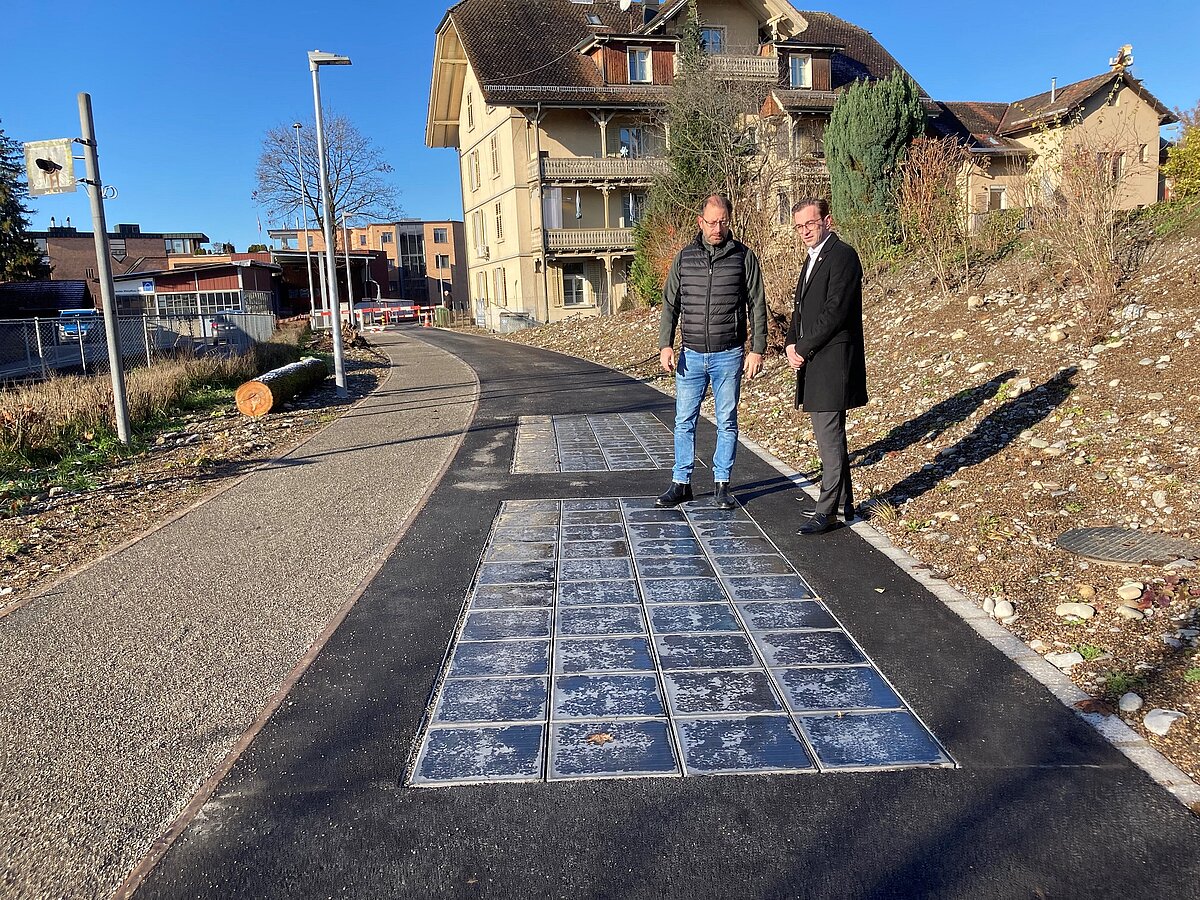Make way for the new Papierigleisweg in Cham: a groundbreaking, sustainable project
The new pedestrian and cycle path between Papieri and Nestléstrasse in Cham was opened yesterday by local councilor Drin Alaj as the groundbreaking and sustainable project was officially handed over to the public. Creating a safe connection for non-car traffic is also a boon for the nature along the wayside. The new charging station for electric bicycles is powered by solar cells made from recycled plastic that are integrated into the path itself – a first in Switzerland.
After several months of construction work, pedestrians and those who prefer to travel by bike can use the new path running between Papieri and Nestléstrasse in Cham. The surface is both asphalted and macadamized, so the path is meticulously integrated into the historic track system, therefore keeping the historic railway route free for those traveling under their own steam. “It’s an absolute delight for us to be able to hand over the Papierigleisweg officially to the public, an area that has been carefully and sustainably constructed to add yet another lovely, safe path to Cham’s network of non-car routes,” enthused Councilor Drin Alaj, Head of Traffic and Safety for the Cham community.
Historical site still visible
The foundations for the Papierigleisweg that we see today were actually laid and constructed around 100 years ago. In 1920, a siding was built especially for the former Cham paper mill and was used for the plant’s own railway to transport materials. A century on, the old tracks, a few parts of old machinery and − hidden in the ground − the hundred-year-old track bed (which now serves as the foundation for the new path) are an enduring reminder of the former railway line. From now on, the Papierigleisweg will welcome everyone who wants to get around on foot or by bike – and it’s good news for nature, too. “The natural environment was a key consideration, with site-specific measures to nurture flora and fauna along the entire route,”
says Transport Project Manager Antonio Milone. Dead wood is gathered in certain spots to provide a habitat for insects and other creatures such as hedgehogs. The habitats of many wild bee species were also preserved along the old industrial tracks and supported with additional appropriate measures. Pupils from Städtli primary school cultivated native plants here as part of a nature project, with expert guidance from the Cham town maintenance team. “This initiative promotes nature and environmental education all at once,” says Antonio Milone.
Innovative solar technology for electric bikes
An e-bike charging station in the Neudorf area also underlines the connection with the former paper mill train, which was electrically powered and relied on rechargeable battery systems in its day. Today, however, the electricity is generated by solar cells made from recycled plastic that are embedded in the pathway and feed directly into the charging station. Any excess electricity is either fed into a battery that is used to charge e-bikes on cloudy days, or into the network of the Städtli II primary school. This unique pilot project is supported and subsidized by the Swiss Federal Office of Energy. “This is the first system of its kind in Switzerland,” says Councilor Drin Alaj. “This small-scale system should give the Cham community a valuable insight into whether solar units on the surfaces of roads and pathways prove worthwhile in terms of generating electricity, operation and upkeep.” By preserving the historic railway tracks, the Papierigleisweg connects the past and future, even if now the surface features solar cells. Cham is breaking new ground with the asphalt surface, too, having deliberately opted for a surfacing material with a very high level of recycled content.

